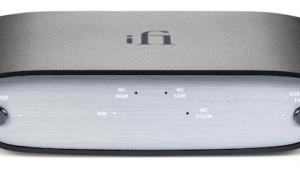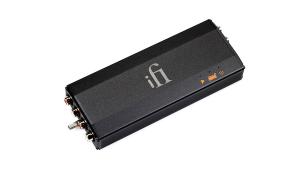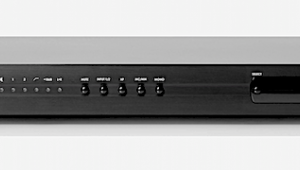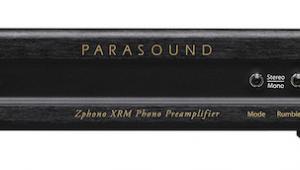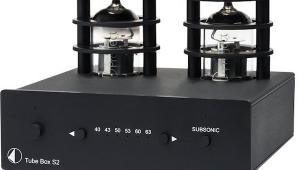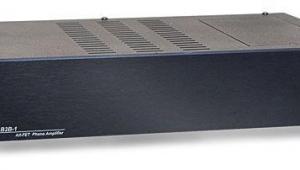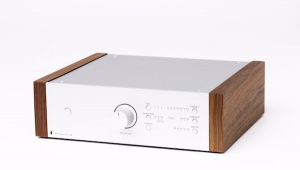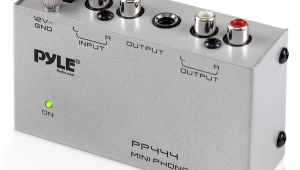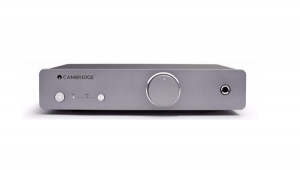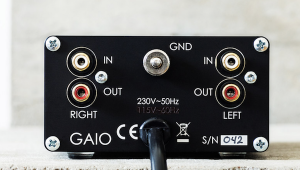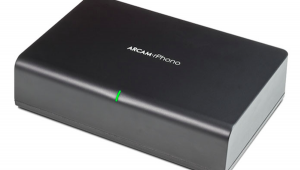Mikey, why do you have a meltdown whenever someone, who obviously does not have the knowledge you have, makes unqualified statements.
Graham Slee's $1449 Accession Raises the MM Playback Bar
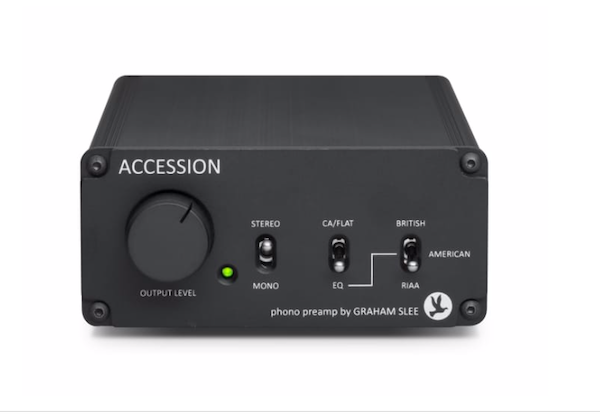
The Accession’s instruction manual opens with a short, imprecise history of electric phonography that may confuse some readers. On the manual’s page 3 Slee claims that “In the beginning…cutter heads cut records with falling treble and the record were played back with the rising treble response of early high output moving coil cartridge—one cancelled out the other and no equalization was required—what the listener heard was flat.”
Here he’s not referring to recent history but instead to the period of time when phonographs went from acoustical to electric playback. To compensate for falling high frequency response treble boost was added. Then came piezoelectric cartridges that were amplitude proportional (displacement-based) like today’s optical and strain gauge cartridges not velocity-based transducers like moving magnet and moving coil cartridges (and cutter heads) and so required no equalization. The problem of course is that equalization is “baked into” the grooves of every record you now play. In any case, if you want to really learn all about this read the excellent article in Stereophile “Cut and Thrust: RIAA LP Equalization” by Keith Howard.
I’m afraid Mr. Slee’s history and description of modern playback will only confuse most readers in part because it is confusingly written and in part because it contains some grievous errors. He claims that if you play an RIAA encoded record (most every record in your collection) using a magnetic cartridge into a line input of your preamp the sound will be “all toppy” because the cartridge output rises at 6dB/octave. That is it doubles in amplitude for every doubling of frequency. Of course the RIAA equalization ‘baked’ into the record also has a rising frequency response. You can read a more complete and useful analysis by Slee on his own website but I find it curious that while he addresses the need to boost high frequencies in disc cutting, in his analysis he completely ignores the need to reduce bass in order to limit the cutter head excursion, which allows for longer sides and makes tracking the grooves far easier. For some reason he claims “RIAA records have boost from 50Hz to 500Hz….”no, they do not—as this RIAA graph shows! Boost, of course, comes in playback.
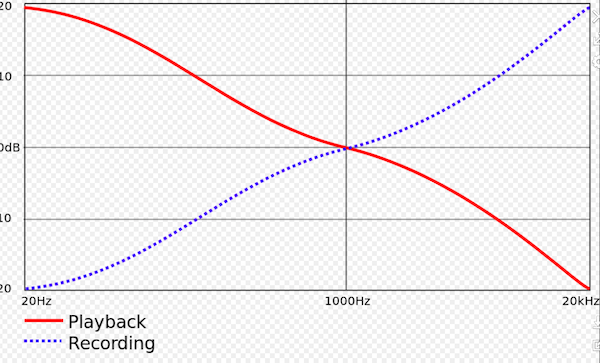
In any case, Mr. Slee claims in his instructions that his circuit does separately record EQ (inverse RIAA—the red line in the above graph) and magnetic cartridge de-emphasis (since cartridges inherently boost response by 6dB octave). You’d think if the record has one curve “baked in” (blue) and the cartridge inherently produces the opposite (similar to the red curve), RIAA circuitry would not be necessary, but of course it’s not quite that simple because it is more than just a basic low pass filter. There’s a “shelf” at the RIAA curve’s 3 “turnover” points of 50Hz, 500Hz and 2122Hz. Why do you have to know this stuff? You don’t! But if you’re interested, go to the two hyperlinked sites.
Mr. Slee’s point is that by separately doing the RIAA and the magnetic cartridge response correction (honestly, this is all news to me—I’ve never previously heard this discussed or mentioned anywhere) the Accession more precisely handles the turnover points rather than having to “decide (one or the other points) empirically”. There are other theoretical advantages to doing it this way, but I’ll skip them for the purposes of this review.
Four EQ Settings
The Accession includes 4 EQ settings: RIAA, NAB, FFRR and “flat”. Because of how Slee’s circuit accomplishes this, there is no interaction between the record EQ and the magnetic cartridge response correction, the correct “shelf” frequencies for each of these curves can be precisely calculated rather than approximated.
The “flat” setting is the one to use if you wish to digitize vinyl and use a program like Channel D’s “Pure Vinyl” program to apply EQ in the digital domain. That program offers a dizzying number of precisely calculated curves for 78rpm records and “oddball” curves and is said to be more precise than any analog filter, but of course you’re digitizing your analog.
Set the EQ switch to “British” for UK DECCA FFRR mono (don’t believe anyone who tells you this curve persisted into the stereo age at DECCA) and for pre 1953 English Columbia records, and to “American” for pre 1953 American Columbia and probably Capitol as well.
The Accession also includes a very useful “mono” switch. Again, to my amazement Slee writes about this switch “Some mono records can give an undesirable whirling or swishing effect due to the record middle being slightly eccentric. Use the mon switch to effect an improvement”.
WTF? That is not the main benefit of a mono switch, which is that when playing a mono record with a stereo cartridge, flipping the mono switch will null out all unwanted vertical modulation products ie: rumble. That makes a huge difference!
Finally there’s the volume pot, which via the variable output can control a power amplifier’s output obviating the need for a preamplifier. Or you can use that output for recording to an A/D converter and set the level to prevent clipping which is really useful. Finally the rear panel includes dipswitches for capacitive loading choices of 100pF, 220pF or 320pF as well as a ground terminal.
Slee provides an outboard PSU1 power supply that can be placed well away from the turntable and the Accession itself, in order to minimize noise. Of course if you are using a moving magnet, a moving iron or a high output moving coil cartridge and later decide to go to a low output moving coil cartridge you can just add an outboard step up transformer (SUT) and you’re good to go!
- Log in or register to post comments



"possible phono preamps to look at and decide on a purchase when ready", but:
1) volume knob makes no sense
2) Any time a manufacture makes ridiculous claims or screws up historical facts severely and puts it out there, etc. I automatically throw the piece into the BS snake oil bucket and take it to the dump.
I figure if one is going to make errant claims without checking or vetting and stick by them.....well, then something is wrong and caveat emptor.
I see no "melt-down" in what Michael wrote.
By the by, I didn't mind Vanessa Fernandez version of When The Levee Breaks or Kashmir, etc. I thought it was different and not bad or good, just different. My favorite version? No, still prefer the Led Zep version of Levee Breaks, but she did ok. She just offered up a different take on it, just as Led Zep did with their version.


Hi Mike,
I run a ShureV15V with Jico. Plan on sticking to MM's. How would you say this compares to the Era Gold or Reflex stages?


Hi,
I also have the same question. Have you got an answer?
It would be very interesting to know the differences between REFLEX M vs ACCESSION M
Thank you,

was due to a distinct lack of whirling or swishing.


A few minutes of research would've told you that GS actually holds a patent on the EQ method used in the phono stage. Perhaps if you read the patent you might understand the point of the phono stage. If not you could've cleared up any confusion with the manufacturer. There is also a separate MC-only model for LOMC users.


“Previously, pre-amplifiers treated the input signal as being homogenous—as if the record was outputting the frequency response FIG. 3C, which is today typically thought of as being the RIAA record output response. However, this is not in fact the case. Instead, as the inventor of the present application has appreciated, it should be thought of as the record response of FIG. 3B elevated by the rising response of the magnetic phono cartridge shown in FIG. 3A.”
Effectively it is saying that until this “invention” prior phono amplifiers just corrected the pick-up input for the RIAA curve, with its three “constants” but not the increase in cartridge output of 6dB/octave because of the nature of magnetic “derivative” or “velocity vs displacement” reading of the groove.
That cannot be correct, even the most basic phono amps correct for both. If I understood it right, in GS’s amp, these corrections are done by separate amplifier stages rather than in a single loop, but that is a choice a designer can make, it does not mean other designers ignored the 6dB/octave correction.



There is information and confusion in all of this and some of it has to do with industry parlance.
See, when audio engineers talk of “equalization” they only refer to what they add or subtract voluntarily and not to the extra they have to do because the magnetic medium requires it. Let me explain.
If you make a “flat” recording (on vinyl or tape, same thing), when a magnetic reader (a tape head or a magnetic cartridge) plays it back, the playback will have 6dB volume increase per octave. Why? Because magnetic devices cannot “read” the actual level of magnetism, they can only read its changing, or, in mathematical language, the “derivative” of the magnetic field. It just so happens that the derivative of a sine wave increases in amplitude with increasing frequency, exactly 6dB/octave at that. So a RIAA or any playback amp (NAB, CCIR, what have you) has to correct for this innate 6dB/octave rise.
What is called “equalization” is laid on top of this innate need for correction. Why? Because in analog recording there are limitations on what a piece of tape or vinyl will comfortably accommodate, compounded by where much of the recorded information resides. Over decades engineers have come up with compromises to accommodate these needs. Again, this has nothing to do with the 6dB/octave innate magnetic “derivative” rise, as Slee points out.
As a coda, non-magnetic and MR systems (piezo, optical, strain gage cartridges as well magnetoresistive tape playback heads used in hard drives and DCC and some later Technics cassette players) do not suffer the 6dB/octave rise so their equalization would be pure RIAA (or NAB, DIN, CCIR) without a need for “innate” magnetic correction.
This, I believe, has continued to confuse generations of audio enthusiasts.


The graph in the article makes recording and playback equalizations look like mirror images. They are not. The PB equalization has a much steeper downward slope, to compensate for the 6dB/octave magnetic pickup due to the amplitude increase from sine function’s derivative. I know in the “industry” they refer to these matters as “displacement” vs “velocity” but I find those expressions further complicate matters (like, displacement is the vector form [i.e., quantity + direction] of the scalar “distance” and “velocity’ of “speed” but no real need for any of those here as direction is not of any consequence for RIAA equalization).

and am using it with a Bob's Devices Sky 40 SUT. Outstanding combination, with some very expensive MC cartridges. By the way, Graham Slee also sells an MC version of the Accession, and an upgraded power supply is available, but it's not as good as the MM version plus SUT, in my experience.

and am in total agreement with the qualities that you mentioned Michael. I think this was a very positive review and, based on my own experience, a very accurate description of the Accession's virtues. Thanks Michael!

Thanks for another great review Michael. Anyone know of a US dealer for the MC version? I've googled, but can't find one. Thanks.

LP Gear in Las Vegas is listing the MC Accession on their website, partnered with the upgraded Enigma power supply. I highly recommend this PS for the MC version, it makes a major difference.

Highly recommend signing up as a member at the Graham Slee forums and taking advantage of their member discount. I bought an Accession last month - I saved a significant amount of money by using the 5% forum member code and buying direct...even with shipping the cost was something like 75% of what it would have been from a US dealer. I had it in my hands something like 10 days after ordering (that's accounting for build time as well as shipping). They also have a fantastic, free loaner/audition scheme.

It appears Mike may have misread the manual. Graham Slee gives an explanation on his forum. 9TA ceramic + Sp25 takes me down memory lane.
https://www.hifisystemcomponents.com/forum/correcting-michael-fremer_top...

I'm wondering if you have any recommendations for an MM cartridge that you feel would be a good match for the Accession. I bought one last month - and love it, dearly - and it's almost new cartridge time.

is so flexible and capable it will match any cartridge. Fellow owners that I've seen post their equipment have listed a great variety of cartridges and everyone seems, like me, thrilled with the results.

I upgraded from the Graham Slee Era Gold to the MM Accession. I have a Dynavector 20XH2 high output MC cart. Why the upgrade? 1) I play alot of mono jazz records from the 50s and wanted the mono switch. 2) I rip all my vinyl to the cloud. I don't think I saw it in the review, but there are 2 sets of outputs. I send 1 directly to my amp and the other into my laptop for recording.

I am seriously looking at buying this preamp for my secondary system. I’m currently using a Graham Slee 2se with a 24v sBooster external power supply. I was also looking at possibly digitizing some of my LPs as well. What would you recommend to use in between.


Michael, you often make a point that one should get a MM preamp if that is the type of cartridge being used. I see the point completely, since otherwise you are paying for all of the extra work/materials to make a high quality MC stage. But suppose one could get a Parasound JC3 for the same price as an Accession, would you suggest the Graham Slee or the Parasound, even if only MM carts were being used?

Hello all,
I have just purchased a Ortofon Credenze Blue, and want to get a good MC preamp to go with. Also I have a Rega Planar 3 and the tonearm might be somewhat underspeced for the quality of the Cartridge.
I am leaning towards the Graham Slee Accession but see Sutherland, Hegel, and Lehmann have good products.
Anyone have a good preamp to go with the Credenza Blue - or should I get the Ortofon transformer instead? Regards, John





